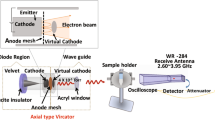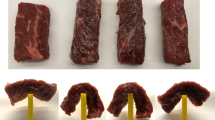Abstract
RECENTLY S. J. W. and Dodds reported that 136 GHz microwaves interfere with the growth of Escherichia coli cells1. Here we report further investigations of the absorption of 65 to 75 GHz microwaves by cells of E. coli BR as well as isolated protein, RNA and DNA, and its effect on some metabolic processes. Our equipment has been described1,2. Cells were grown for 24 h at 37° C in nutrient broth (NB) and either (a) washed twice in 0.85 per cent NaCl and deposited as a pellet by centrifugation or (b) resuspended after washing to a cell concentration of 1 × 106 cells/ml. in 0.5 per cent glucose + 0.5 per cent casamino-acids + 50 µg/ml. thymine in 0.1 M phosphate buffer, pH 6.9 (GCT). To examine the effect of microwaves on cell growth, 0.5 ml. aliquots of cells suspended in GCT were placed in vials 1.5 cm in diameter. Some vials were put on top of microwave horns and others incubated at the same temperature (25° C) out of the radiation field. At various times the vials were removed and the number of cells/ml. determined by dilution and plating on nutrient agar. The effect of microwave absorption on metabolic processes was investigated by resuspending the washed cells to a concentration of 1 × 108 cells/ml. in 1.0 per cent glucose in 0.1 M phosphate buffer, pH 6.9. Aliquots of 0.2 ml. of this suspension were placed in the vials and after positioning on the microwave apparatus 0.3 ml. of a solution was added, which contained 0.8 µCi/ml. of one of the following: thymine-2-14C, uracil-2-14C or algal 14C protein hydrolysateplus two of the following: unlabelled thymine, 50 µg/ml.; uracil, 100 µg/ml.; or casamino-acids, 500 µg/ml. After various times the cells from each vial were deposited onto a Millipore filter and washed with 100 ml. of 1 N HCl; the filter was dried and radioactivity counted. The microwave absorption spectra of the cells, H2O, protein, RNA and DNA were obtained by making films of the material on a thin mica window. The films were dried at 80 per cent relative humidity and covered with a second thin piece of mica. The difference between the microwave absorption of a blank and the film gave the absorption spectrum of the film of cells or biological material.
This is a preview of subscription content, access via your institution
Access options
Subscribe to this journal
Receive 51 print issues and online access
$199.00 per year
only $3.90 per issue
Buy this article
- Purchase on Springer Link
- Instant access to full article PDF
Prices may be subject to local taxes which are calculated during checkout
Similar content being viewed by others
References
Webb, S. J., and Dodds, D. E., Nature, 218, 374 (1968).
Dodds, D. E., M. Sc. thesis, University of Saskatchewan (1968).
Sutherland, G. B. B. M., and Tsuboi, M., Proc. Roy. Soc., A, 239, 446 (1957).
Falk, M., Hartman, K. A., and Lord, R. C., J. Amer. Chem. Soc., 85, 387 (1963).
Webb, S. J., and Dumasia, M. D., Canad. J. Microbiol., 14, 841 (1968).
Webb, S. J., and Bhorjee, J. S., Canad. J. Biochem., 46, 691 (1968).
Author information
Authors and Affiliations
Rights and permissions
About this article
Cite this article
WEBB, S., BOOTH, A. Absorption of Microwaves by Microorganisms. Nature 222, 1199–1200 (1969). https://doi.org/10.1038/2221199a0
Received:
Revised:
Issue Date:
DOI: https://doi.org/10.1038/2221199a0
This article is cited by
-
Unusual microwave heating of water in reverse micellar solution
Scientific Reports (2023)
-
5G mobile networks and health—a state-of-the-science review of the research into low-level RF fields above 6 GHz
Journal of Exposure Science & Environmental Epidemiology (2021)
-
Electromagnetic and microwave absorption performance of Ni0.4Zn0.4Co0.2Fe2O4/polymethacrylimide foam synthesized via polymerization
Journal of Materials Science: Materials in Electronics (2019)
-
Is DNA a nonlinear dynamical system where solitary conformational waves are possible?
Journal of Biosciences (2001)
Comments
By submitting a comment you agree to abide by our Terms and Community Guidelines. If you find something abusive or that does not comply with our terms or guidelines please flag it as inappropriate.



